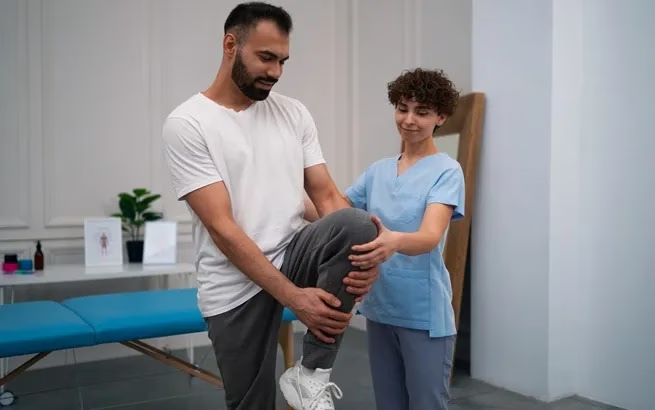Living with chronic pain can be a daily struggle that significantly impacts your quality of life. Whether you’re dealing with back pain, arthritis, or nerve damage, finding effective and advanced pain management solutions is essential for regaining control of your health and well-being.
The latest pain control methods range from drugs to treatments like topical relief. These strategies aim to address the source of discomfort, working towards lasting ease.
This blog will explore the best ways to tackle persistent pain, touching on gentle and extensive treatments alike.
What is Advanced Pain Management?

Advanced pain management refers to the use of specific treatments and techniques to help patients manage chronic pain conditions more effectively.
Such care typically uses a team effort. It includes medical treatments, exercises, mental wellness techniques, and daily routine adjustments to deal with the root of the pain.
The goal is not just to help the symptoms but to improve the patient’s overall quality of life.
Common conditions treated by advanced pain management include:
- Chronic back pain
- Arthritis
- Nerve pain (neuropathy)
- Fibromyalgia
- Sciatica
- Migraines
Types of Advanced Pain Management Techniques

Several forms of advanced pain management are widely used to treat chronic pain:
1. Medications
We often turn to medications when we’re hurting. This can be something simple, like an Advil we grab from the cabinet, or a heavy-duty prescription painkiller.
Despite being common, taking pills isn’t a long-term fix. Well, they can cause problems.
Side effects and addiction potential, for starters.
- Anti-inflammatory Drugs: These medications reduce inflammation and provide relief for conditions like arthritis and back pain.
- Muscle Relaxants: These can be helpful for muscle spasms that contribute to pain.
- Nerve Pain Medication: Drugs like gabapentin are prescribed specifically for neuropathic pain.
2. Physical Therapy
Physical therapy is often used to help manage severe pain. It employs exercises and techniques to strengthen our muscles, increase flexibility, and relieve the tension that causes ongoing discomfort.
A proper routine of physical therapy can significantly decrease pain, and no invasive treatments are required.
3. Interventional Procedures
For severe and persistent pain, doctors may recommend interventional procedures such as:
- Epidural Steroid Injections: These provide immediate and long-term relief for conditions like sciatica or lower back pain.
- Nerve Blocks: By blocking nerve activity, these injections prevent pain signals from reaching the brain.
- Radiofrequency Ablation: This involves using heat to disrupt nerve function and block pain signals.
4. Topical Pain Relief
For people who like treatments without any invasion, topical solutions for pain relief are a fast and efficient choice.
They are especially good for pain localised in a specific area, like aching muscles or joints.
Top-notch pain easing items are often creams, gels, or patches. They have stuff like menthol, capsaicin, or lidocaine. These help to make the hurting spot numb and lessen the pain.
Some of the most effective topical treatments include:
- Lidocaine Patches: These numb the skin and can provide relief for nerve pain.
- Capsaicin Cream: This cream contains an ingredient derived from chili peppers and is effective for treating joint pain or arthritis.
- Menthol Gel: provides a cooling sensation that helps reduce inflammation and discomfort in irritated muscles.
Benefits of Advanced Pain Management

Advanced pain management provides several benefits that extend beyond just pain relief. By combining different methods, patients can expect:
- Improved Mobility: A lot of strategies for managing pain aim to build up the muscles and enhance flexibility. This way, patients can move with less restriction.
- Reduced Dependence on Medications: With the help of physical therapy and interventional procedures, patients can reduce their reliance on pain medications.
- Specific Care: Pain clinics, ones that are advanced, usually provide a variety of treatment options. These are based on what each patient needs.
This guarantees that the approach to easing the pain is thorough and all-inclusive.
- Long-Term Relief: Instead of temporary fixes, advanced pain management aims to provide long-lasting relief by treating the root cause of the pain.
Finding the Best Topical Pain Relief
Think about spot-on pain comforts. Make sure you pick items that work well and fit your unique pain situation.
Here are some things to keep in mind when choosing the right spot-on pain soothers:
- Active Ingredients: Look for products that contain proven ingredients like lidocaine, menthol, or capsaicin.
- Ease of Use: Consider whether a cream, patch, or gel is more convenient for your lifestyle.
- Effectiveness: Some products work better for certain types of pain, such as nerve pain versus joint pain.
If you’re unsure which product is right for you, consult a pain specialist who can guide you toward the best solution.
When to Seek Help from a Pain Specialist?
If you have had ongoing pain for a while now and regular medicines or creams fail to soothe it, when this happens, meeting with a pain expert could be your next step.
These professionals can evaluate your condition and suggest more advanced treatments that target the source of your pain.
Visiting an FMRC pain management clinic can guide you toward alternatives. You might consider things like injections, nerve blocks, or physical therapy. These might offer long-term relief.
Conclusion
Advanced pain control gives many treatments planned to reduce long-lasting pain and boost the quality of life for patients.
From drugs, movement therapy, and Procedures and techniques to top surface pain relief, current pain control techniques are changed to focus on each patient’s special requirements.
By seeking help from experienced pain specialists, you can find the right combination of treatments to achieve lasting relief and a better quality of life.
FAQ’s
Q1: What types of conditions can advanced pain management treat?
A: Pain management techniques are versatile. They help with many issues like constant back discomfort, arthritis, neuralgia, fibromyalgia, and frequent migraines.
Q2: Are topical pain relief treatments effective?
A: Yes, topical methods for pain relief work well for pain in a specific area, especially in muscles and joints. They are a practical choice for temporary help without intrusion.
Q3: When should I see a pain specialist?
A: When persistent discomfort defies common treatment and physical therapy, consider contacting a pain expert. They can provide sophisticated solutions, including injections or nerve blocks.

